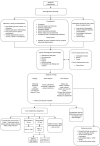Pediatric Nephrolithiasis
- PMID: 36833086
- PMCID: PMC9957182
- DOI: 10.3390/healthcare11040552
Pediatric Nephrolithiasis
Abstract
The prevalence of pediatric nephrolithiasis has increased dramatically in the past two decades for reasons that have yet to be fully elucidated. Workup of pediatric kidney stones should include metabolic assessment to identify and address any risk factors predisposing patients to recurrent stone formation, and treatment should aim to facilitate stone clearance while minimizing complications, radiation and anesthetic exposure, and other risks. Treatment methods include observation and supportive therapy, medical expulsive therapy, and surgical intervention, with choice of treatment method determined by clinicians' assessments of stone size, location, anatomic factors, comorbidities, other risk factors, and preferences and goals of patients and their families. Much of the current research into nephrolithiasis is restricted to adult populations, and more data are needed to better understand many aspects of the epidemiology and treatment of pediatric kidney stones.
Keywords: epidemiology; kidney stone disease; nephrolithiasis; pediatrics; percutaneous nephrolithotomy; radiation exposure; shock wave lithotripsy; ultrasound; ureteroscopy.
Conflict of interest statement
The authors declare no conflict of interest.
Figures


References
-
- Hill A.J., Basourakos S.P., Lewicki P., Wu X., Arenas-Gallo C., Chuang D., Bodner D., Jaeger I., Nevo A., Zell M., et al. Incidence of Kidney Stones in the United States: The Continuous National Health and Nutrition Examination Survey. J. Urol. 2022;207:851–856. doi: 10.1097/JU.0000000000002331. - DOI - PubMed
-
- Tasian G.E., Ross M.E., Song L., Sas D.J., Keren R., Denburg M.R., Chu D.I., Copelovitch L., Saigal C.S., Furth S.L. Annual Incidence of Nephrolithiasis among Children and Adults in South Carolina from 1997 to 2012. Clin. J. Am. Soc. Nephrol. 2016;11:488–496. doi: 10.2215/CJN.07610715. - DOI - PMC - PubMed
Publication types
LinkOut - more resources
Full Text Sources
Miscellaneous

